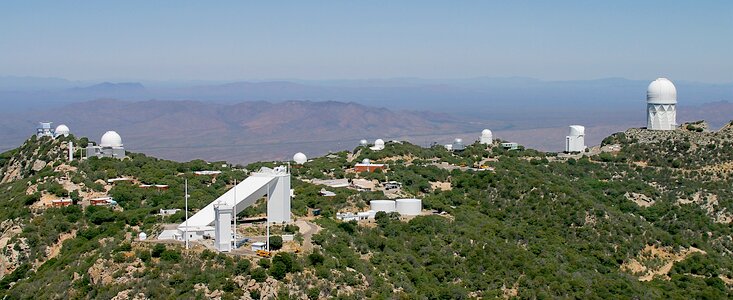noaoann10010 — Anuncio
History of Iolkam Du’ag and the Birth of Kitt Peak National Observatory Celebrated
Special talks by astronomer, Dr. Aden B. Meinel and Tohono O'Odham representative, Bernard Siquieros
10 Marzo 2010
Our national astronomy observatory was dedicated on Kitt Peak 50 years ago in March 1960. In celebration of the 50th anniversary, Kitt Peak National Observatory’s first Director Dr. Aden B. Meinel will speak about the history of the national observatory and Bernard Siquieros, Education Curator of the Tohono O’odham Nation’s Cultural Center and Museum, will share a Tohono O’odham perspective on the meaning and history of Iolkam Du’ag, or Kitt Peak, and the Baboquivari Range.
The program entitled “Why Kitt Peak?” will be presented at the Steward Observatory, 933 North Cherry Avenue, Room N210, at 7:30 pm on Monday, March 22nd; it is free of charge and open to the public. Following the talks, the telescope in the Steward Observatory dome will be open for public viewing of the night sky (weather permitting).
The site for the proposed national observatory was constrained by practical considerations that limited the choice to somewhere within a narrow strip of southern Arizona and New Mexico. Of four final test sites found to have essentially the same quality of astronomical seeing, the Kitt Peak site proved superior in terms of practical requirements and was selected. The challenge of developing this isolated site was met through close cooperation with the Tohono O’odham Tribal Council, Shuk Toak District Council, Pima County, and the University of Arizona. A movie of Dr. Meinel’s first ascent of Kitt Peak using packhorses will be shown.
Aden B. Meinel received his Ph.D. from the University of California, Berkeley in 1949. In 1955, he accepted the position of Executive Secretary for the National Science Foundation’s advisory panel (chaired by Robert McMath) on the establishment of a national observatory. Meinel managed selection and testing of the observatory on Kitt Peak from1956 —1958 and became the first director in 1958 when construction began. He served as a professor at the University of Arizona (UA) from 1960 — 1980, as third director of Steward Observatory, and in 1965, was the founding director of the UA’s Optical Sciences Center where he currently holds the position of Professor Emeritus. He retired in 1993 as a Distinguished Scientist at the Jet Propulsion Laboratory. His research interests have included upper atmospheric physics, glass technology, optical design, instrumentation, and space systems.
Kitt Peak served as the birthplace of our national observatories. By the late 1950s, the National Observatory had begun building roads and telescopes on Kitt Peak as well as a headquarters in Tucson. During its first 50 years, Kitt Peak National Observatory (KPNO) helped change our understanding of the universe, advanced telescope and instrument operations and design, and contributed to the training of a large fraction of the astronomy community. KPNO continues to be an active and vital observatory in the U.S. System that began at Kitt Peak with the landmark concept of a national observatory open to all astronomers based on the merit of their scientific proposals.
About Kitt Peak and NOAO
Featuring the world’s largest collection of optical telescopes, Kitt Peak National Observatory is located fifty-six miles southwest of Tucson, in the Schuk Toak District on the Tohono O’odham Nation. Kitt Peak National Observatory, part of the National Optical Astronomy Observatory, was founded in 1958. The Kitt Peak National Observatory Visitor Center is open to the public daily from 9 a.m. to 4 p.m., except Thanksgiving, Christmas, and New Year’s Day. The Kitt Peak Visitor Center is a non-profit educational organization. The visitor center uses earned income and donations to support its operation. There is no fee for admission to the visitor center; three daily docent-led tours of the major telescopes are offered for a fee.
Members of the public should call 520-318-8726 or visit the Kitt Peak Public Programs webpage for information about programs and visiting Kitt Peak.
The National Optical Astronomy Observatory and the National Solar Observatory are operated by the Association of Universities for Research in Astronomy under cooperative agreements with the National Science Foundation.
About the Steward Observatory public evening lectures in astronomy
Since 1922, Steward Observatory has been hosting public evening lectures in astronomy. Following the talks, the Raymond E. White, Jr. telescope in the historic Steward Observatory dome will be open for public viewing of the night sky (weather permitting). All the lectures and use of the telescope are free of charge and open to the general public.

